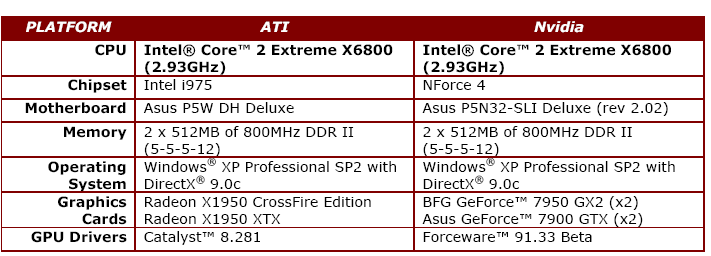ATi
Radeon X1950 XTX Review 1/8
Bluetooth 23 Aug 2006
X1950 XTX
The Radeon X1950 Series is a
continuation of the successful Radeon X1900 Series. The Radeon X1950 Series are
the first products to offer GDDR4 memory at the consumer level. With high speed
GDDR4 memory, gamers can achieve even higher performance, especially at
ultra-high quality settings and resolutions.
Just like its predecessor, the Radeon
X1950 series offers 48 powerful pixel shader processors which provide the
fastest performance in games and other 3D applications that make extensive use
of pixel shaders. Other features exclusive to ATI’s robust Radeon X1000 line of
products include Avivo™ Technology, 3DC+, full precision rendering and many
more.
There are two versions to the X1950
graphics card. The first is the standard card and the other is the CrossFire
edition aka master card. Both cards have a core speed of 650MHz and a memory
speed of 2GHz. It has 48 Pixel Shader processors and 8 vertex shaders. The X1950
Series promises faster performance than Quad Sli with only half the processors
for ultimate gaming experience. It also supports high Dynamic range +AA, Super
AA. It also supports the latest HD Video formats and VISTA drivers.
With its faster high memory clk of 1GHz, it is able to churn out more bandwidth
of 64GB/s. The 7900GTX is only 51GB/s. GDDR4 also consumes less power than
GDDR3. THe X1950 Family also uses a new fansink for quieter operation and
greater overclocking potential.
High-Dynamic Range (HDR) rendering is
one of the most exciting new techniques appearing in new games. It makes use of
floating point processing to capture the full range of color and brightness that
can be perceived by the human visual system. Although HDR dramatically improves
image quality and heightens the gaming experience, the competition’s hardware
does not support Anti-Aliasing with specific HDR implementations. ATI’s line of
Radeon X1K hardware has full capabilities to render HDR with Anti-Aliasing. The
Radeon X1950 Series offers the benefits of High Dynamic Range lighting, while
effectively reducing the amount of aliasing in the scene.
In the next few pages, we present you
pictures of the graphics card and official benchmarks of the card with the
configuration below :

Features
- 384 million transistors on 90nm fabrication process
- Up to 48 pixel shader processors
- 8 vertex shader processors
- Up to 256-bit 8-channel GDDR4 memory interface
- Native PCI Express x16 bus interface
Ring Bus Memory Controller
- Up to 512-bit internal ring bus for memory reads
- Fully associative texture, color, and Z/stencil cache designs
- Hierarchical Z-buffer with Early Z test
- Lossless Z Compression (up to 48:1)
- Fast Z-Buffer Clear
- Optimized for performance at high display resolutions, including widescreen
HDTV
resolutions
Ultra-Threaded Shader Engine
- Support for Microsoft® DirectX® 9.0 Shader Model 3.0 programmable vertex
and pixel
shaders in hardware
- Full speed 128-bit floating point processing for all shader operations
- Up to 512 simultaneous pixel threads
- Dedicated branch execution units for high performance dynamic branching and
flow
control
- Dedicated texture address units for improved efficiency
- 3Dc+ texture compression o High quality 4:1 compression for normal maps and
twochannel
data formats
- High quality 2:1 compression for luminance maps and single-channel data
formats
- Complete feature set also supported in OpenGL® 2.0
Advanced Image Quality Features
- 64-bit floating point HDR rendering supported throughout the pipeline
o Includes support for blending and multi-sample anti-aliasing
- 32-bit integer HDR (10:10:10:2) format supported throughout the pipeline
o Includes support for blending and multi-sample anti-aliasing
- 2x/4x/6x Anti-Aliasing modes
o Multi-sample algorithm with gamma correction, programmable sparse sample
patterns, and centroid sampling
o New Adaptive Anti-Aliasing feature with Performance and Quality modes
o Temporal Anti-Aliasing mode
o Lossless Color Compression (up to 6:1) at all resolutions, including
widescreen HDTV
resolutions
- 2x/4x/8x/16x Anisotropic Filtering modes
o Up to 128-tap texture filtering
o Adaptive algorithm with Performance and Quality options
- High resolution texture support (up to 4k x 4k)
3
Avivo™ Video and Display Platform
- High performance programmable video processor
o Accelerated MPEG-2, MPEG-4, DivX, WMV9, VC-1, and H.264 decoding and
transcoding
o DXVA support
o De-blocking and noise reduction filtering
o Motion compensation, IDCT, DCT and color space conversion
o Vector adaptive per-pixel de-interlacing
o 3:2 pulldown (frame rate conversion)
- Seamless integration of pixel shaders with video in real time
- HDR tone mapping acceleration
o Maps any input format to 10 bit per channel output
- Flexible display support
o Dual integrated dual-link DVI transmitters
o Dual integrated 10 bit per channel 400 MHz DACs
o 16 bit per channel floating point HDR and 10 bit per channel DVI output
o Programmable piecewise linear gamma correction, color correction, and color
space
conversion (10 bits per color)
o Complete, independent color controls and video overlays for each display
o High quality pre- and post-scaling engines, with underscan support for all
outputs
o Content-adaptive de-flicker filtering for interlaced displays
o Xilleon™ TV encoder for high quality analog output
o YPrPb component output for direct drive of HDTV displays
o Spatial/temporal dithering enables 10-bit color quality on 8-bit and 6-bit
displays
o Fast, glitch-free mode switching
o VGA mode support on all outputs
o Drive two displays simultaneously with independent resolutions and refresh
rates
- Compatible with ATI TV/Video encoder products, including Theater 550
CrossFire™
- Multi-GPU technology
- Four modes of operation:
o Alternate Frame Rendering (maximum performance)
o Supertiling (optimal load-balancing)
o Scissor (compatibility)
o Super AA 8x/10x/12x/14x (maximum image quality)

Discuss in Forum
Next >>>
|